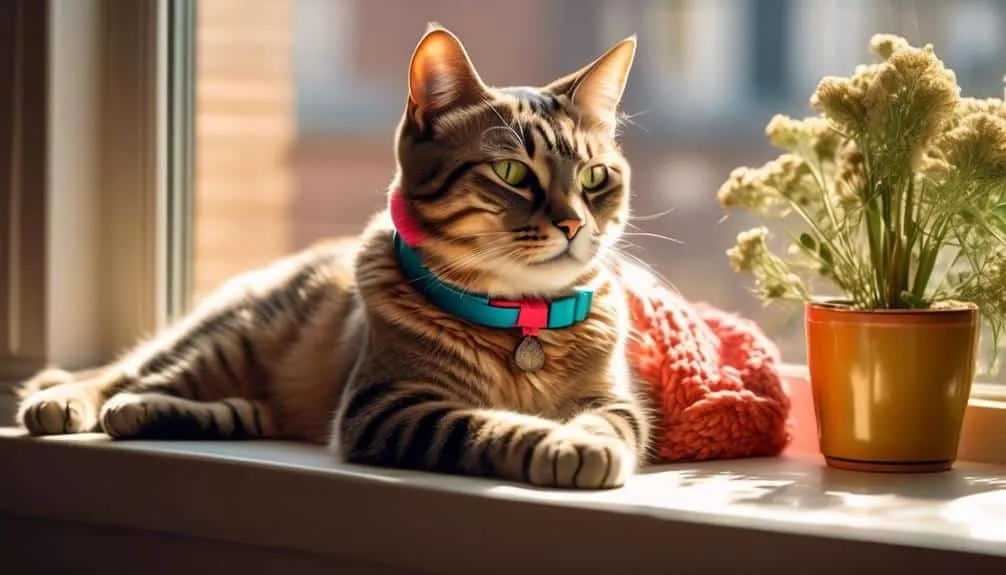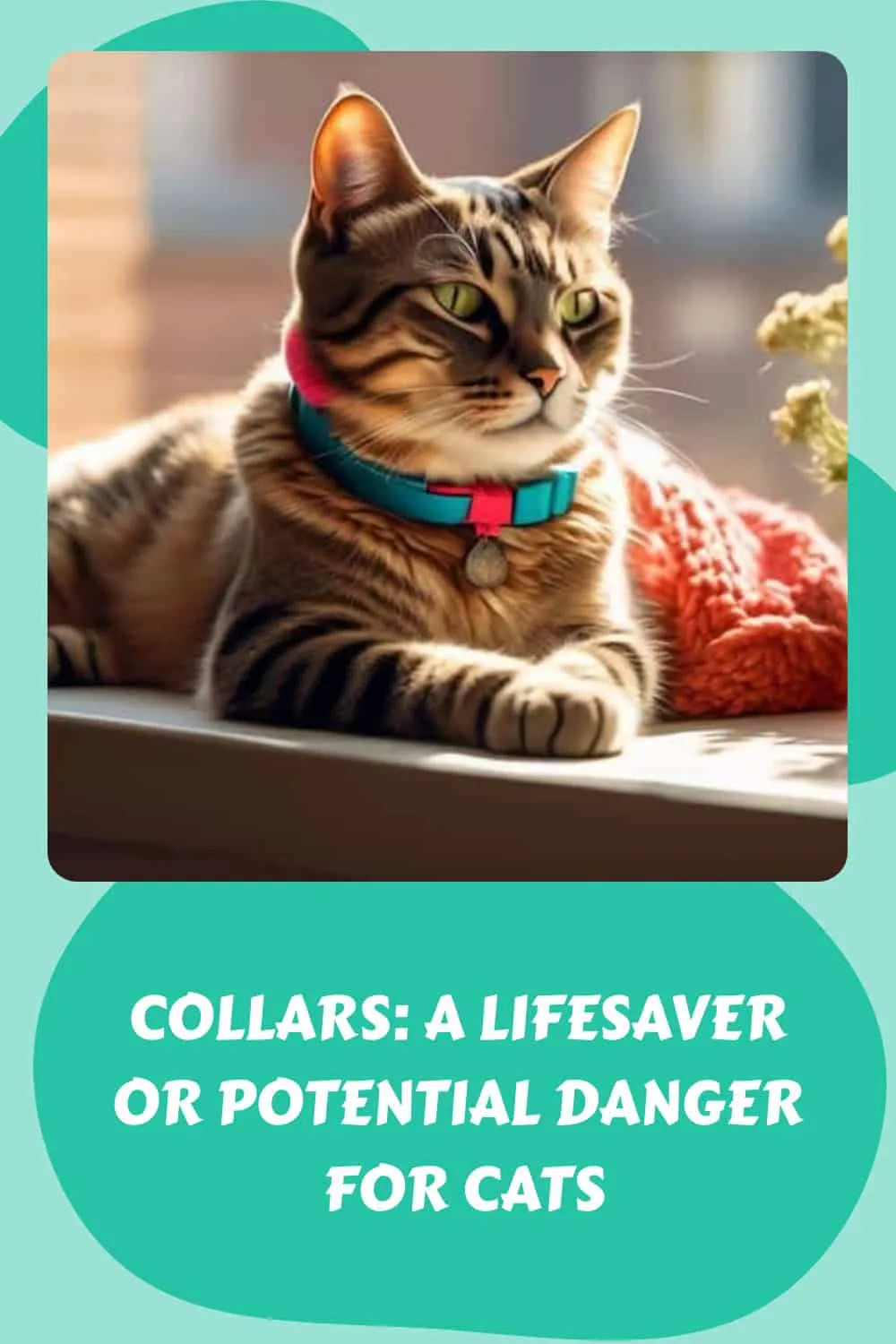The Best Fluffy Pancakes recipe you will fall in love with. Full of tips and tricks to help you make the best pancakes.

Did you know that over 10 million cats go missing each year?
The use of collars is a hotly debated topic among cat owners, with some viewing them as a lifesaver and others as a potential danger.
In this article, we will explore the benefits and drawbacks of cat collars, as well as alternative options and important considerations when choosing the right collar for your furry friend.
As you navigate this discussion, you will gain valuable insights into the world of collars and discover how to prioritize your cat's safety and well-being.
Stay tuned to uncover the truth behind this controversial topic and make an informed decision for your beloved feline companion.
Key Takeaways
- Cat collars can provide instant identification and increase the chances of a lost cat being found.
- Collars offer visual identification and can help differentiate similar-looking kittens.
- However, collars can pose risks to cats, such as getting stuck on objects or causing collar injuries.
- Alternatives to collars, such as microchipping, can also be effective in ensuring cats' safety and identification.
Pros and Cons of Cat Collars
Cat collars have both advantages and disadvantages that should be carefully considered before making a decision.
One important advantage of cat collars is the inclusion of ID tags. These tags provide instant identification for cats, increasing the chances of a lost cat being found. Unlike microchips, collars offer visual identification, which is helpful in differentiating similar-looking kittens and preventing cats from being mistaken as strays.
However, it's crucial to note that collars can impact a cat's behavior and comfort. Some cats may become uncomfortable or exhibit changes in behavior when wearing a collar.
Additionally, there's a small percentage of cats that may experience collar injuries due to poor fitting or low-quality collars. Therefore, it's essential to prioritize the comfort and safety of the cat when choosing a collar.
Factors to Consider When Choosing a Collar
Consider several important factors when choosing a collar for your feline companion. The right collar can ensure your cat's comfort and safety.
When selecting a collar, take into account the material and design considerations. Look for collars made from durable and non-irritating materials, such as nylon or leather. Avoid collars with excessive adornments or decorations that can pose a hazard to your cat.
Additionally, proper collar fit is crucial. Ensure that the collar is adjustable and can accommodate your cat's growth. A collar that's too loose can easily slip off, while a collar that's too tight can cause discomfort or injury.
It's recommended to choose a collar that works best for both you and your cat, providing peace of mind and security for your beloved feline friend.
Alternatives to Collars
When considering alternatives to collars for cats, it's important to explore other options that can provide identification and safety for your feline companion.
While collars can be effective, there are also benefits to having a collar-free cat.
One alternative to collars is microchipping. A microchip is a small electronic chip that's placed under the cat's skin. It requires a specialized scanner to activate the chip and can greatly increase the chances of a lost cat being reunited with its owner.
Another alternative is using monthly spot-on flea treatments instead of flea collars, as some cats may have allergic reactions to the collars.
Should Cats Wear Bells on Their Collars?
As we explore the question of whether cats should wear bells on their collars, it's important to consider the potential benefits and implications of this additional accessory.
Bells on collars have been found to be effective in preventing cat predation, especially on birds and rodents. By alerting potential prey to the presence of a cat, bells reduce the chances of successful hunting, which can have a positive impact on local ecosystems.
Additionally, bells on collars can help locate kittens and prevent accidents, as the sound can serve as an audible warning to humans and other animals.
However, it's crucial to choose a bell that's lightweight and doesn't cause discomfort or restrict the cat's movement. Finding a balance between reducing predation and ensuring the cat's safety is key in deciding whether to add a bell to their collar.
Should Indoor Cats Wear Collars?
Indoor cats can greatly benefit from wearing collars for added safety and identification. While they may not be exposed to the same risks as outdoor cats, accidents can still happen, and collars can provide a safety net in such situations.
Collars make indoor cats more easily identifiable, especially if they manage to escape or get lost. They act as an insurance plan, ensuring that if your indoor cat does wander further away from home when scared or lost, they can be easily recognized and returned to you.
Additionally, adding 'I'm Lost' information on the collar can help identify lost indoor cats quickly. However, if you prefer not to use traditional collars, microchipping is an excellent alternative. Microchips are small electronic devices placed under the skin, and they greatly increase the chances of being reunited with your cat if they go missing.
Monthly spot-on flea treatments can also be used instead of flea collars to prevent allergic reactions. Ultimately, the choice of whether to use collars or alternatives depends on your preferences and the specific needs of your indoor cat.
Collar Injuries: Causes and Prevention
Collar injuries in cats can occur due to various causes, but with proper prevention measures, they can be significantly reduced. Preventing collar injuries is essential for the well-being of your feline friend.
One of the most common collar mistakes is using a collar that's too tight. This can cause discomfort and even lead to injury. It's important to choose a collar that fits properly, allowing enough space for two fingers to fit comfortably between the collar and your cat's neck.
Another common mistake is using a collar with a breakaway feature that's too loose. While breakaway collars are designed to release if your cat gets caught on something, if they're too loose, they may not release properly and can cause injury.
It's crucial to regularly check your cat's collar for any signs of wear and tear, and replace it if necessary.
Microchipping: An Effective Identification Method
Microchipping cats is an effective method of identification that provides a permanent and reliable way to reunite lost cats with their owners. Unlike collars, microchips offer a more secure form of identification as they can't be easily removed or lost. The microchip is a small electronic chip that's inserted under the cat's skin. When scanned with a specialized device, the chip provides a unique identification number that can be linked to the owner's contact information.
One of the main advantages of microchipping is that it eliminates the risk of collar injuries or the collar being lost. However, it's important to note that microchips don't provide visual identification like collars do. Therefore, it's recommended to combine microchipping with other identification methods, such as a collar with tags, for added security.
Safety Tips for Cat Collar Use
To ensure the safety of your cat while using a collar, it's important to follow these essential tips:
- Choose a collar that fits properly: A loose collar can be dangerous as it may get caught on objects or cause your cat to slip out of it.
- Use breakaway collars: These collars are designed to release when pressure is applied, preventing your cat from getting stuck or injured.
- Avoid excessive accessories: While cat collar accessories like bells or tags can be useful, too many can increase the risk of entanglement or injury.
- Regularly check the collar: Inspect the collar for signs of wear and tear, such as fraying or stretching. Replace it if necessary to prevent accidents.
How to Properly Fit a Cat Collar
When fitting a cat collar, ensuring the proper size and fit is crucial for the safety and comfort of your feline companion. Preventing collar accidents and understanding the importance of proper collar sizing are key.
To properly fit a cat collar, measure your cat's neck using a soft tape measure or a piece of string. Leave enough space for two fingers to fit between the collar and your cat's neck. It should be snug, but not too tight.
Check the collar regularly to ensure it hasn't become too loose or tight as your cat grows. Avoid using collars with elastic inserts, as they can stretch and increase the risk of accidents.
Frequently Asked Questions
Are There Any Alternatives to Collars for Identifying Cats?
There are non-collar identification options available for cats, such as microchipping. One beneficial alternative is GPS tracking, which allows you to easily locate your cat if they go missing.
How Can Collars With Bells on Them Help Prevent Cat Predation?
Bells on collars help prevent cat predation by alerting wildlife to their presence. This reduces the risk of cats catching smaller prey and impacting ecosystems. Additionally, the sound can help locate cats and reduce the chances of theft.
What Are the Potential Dangers of Flea Collars for Cats?
Flea collars for cats carry potential dangers, including potential allergic reactions and risks of collar strangulation. It's essential to prioritize safety and choose high-quality collars that fit properly to minimize these risks. Owners should also monitor their cats closely after introducing a flea collar, observing for any signs of discomfort or adverse reactions. Additionally, it’s important to research and consult with a veterinarian to ensure the suitability of the chosen product, as not all collars are created equal. By being informed about the flea collar risks for cats, pet owners can make better decisions for their furry companions.
Can Indoor Cats Benefit From Wearing Collars?
Indoor cats can benefit from wearing collars. They provide identification in case of accidents or getting lost. Collars make indoor cats more identifiable and serve as an insurance plan. Choose a collar prioritizing comfort and safety.
How Does Microchipping Work as a Method of Identification for Cats?
Microchipping is a beneficial method of cat identification. It involves a small electronic chip placed under the skin, increasing the chances of reuniting lost cats with their owners. Risks are minimal, but complications can arise if the chip is not properly implanted or if the scanner is not used correctly.
Conclusion
In conclusion, while cat collars can provide instant identification and help prevent cats from getting lost, they also come with potential risks. It's important to prioritize your cat's comfort and safety when choosing a collar, considering factors such as adjustability and the addition of bells.
Alternatively, microchipping offers a permanent form of identification without the risk of collar-related injuries. Remember, the choice ultimately depends on what's best for your beloved feline friend.
Just as a collar symbolizes protection, make sure your decision symbolizes their well-being.










